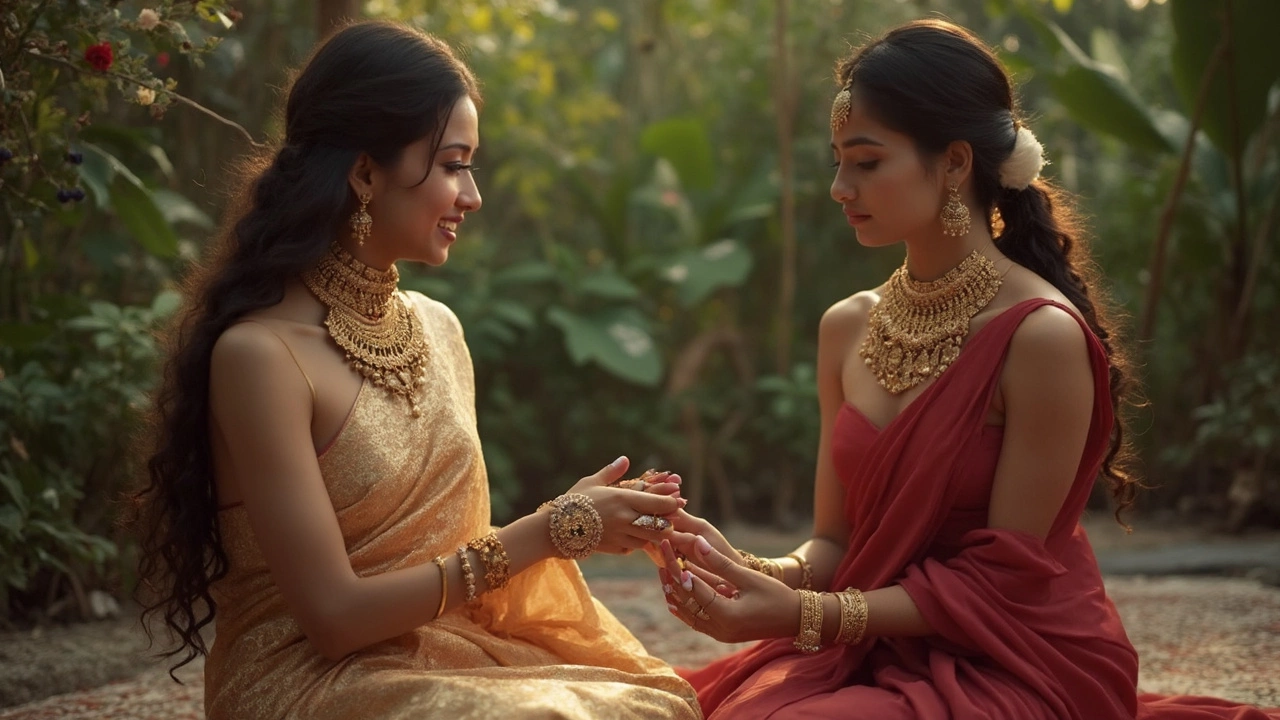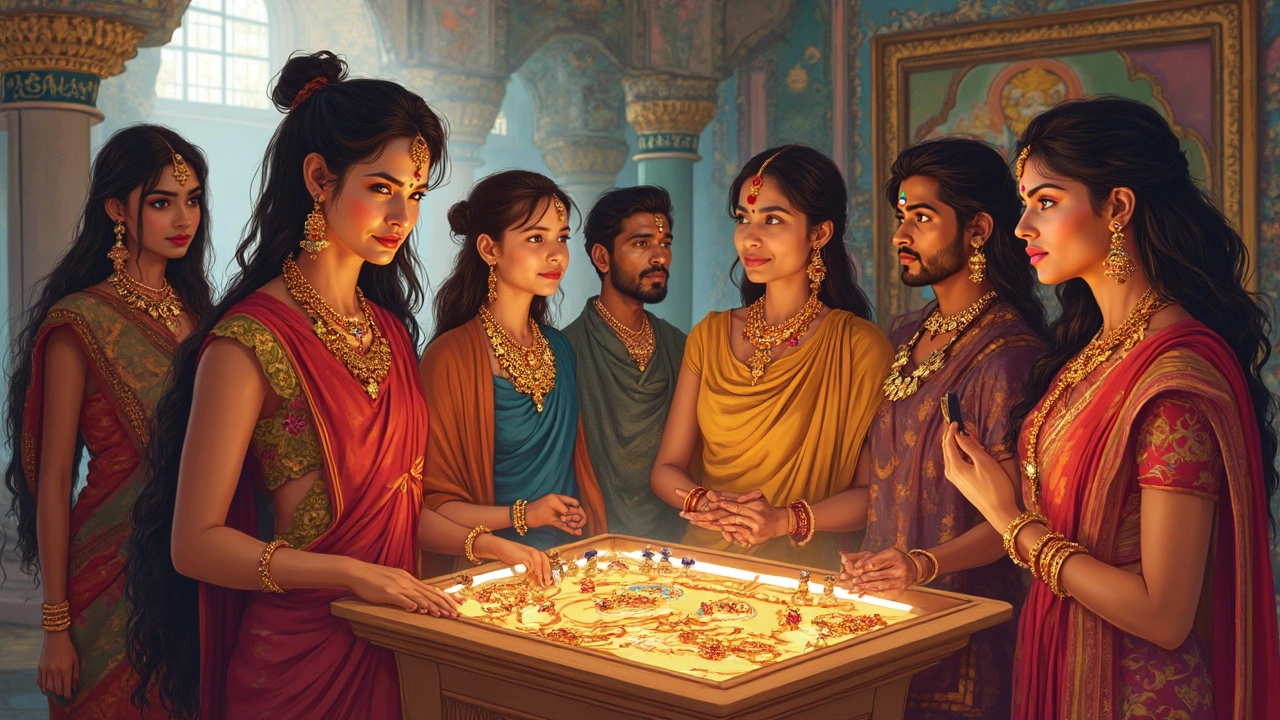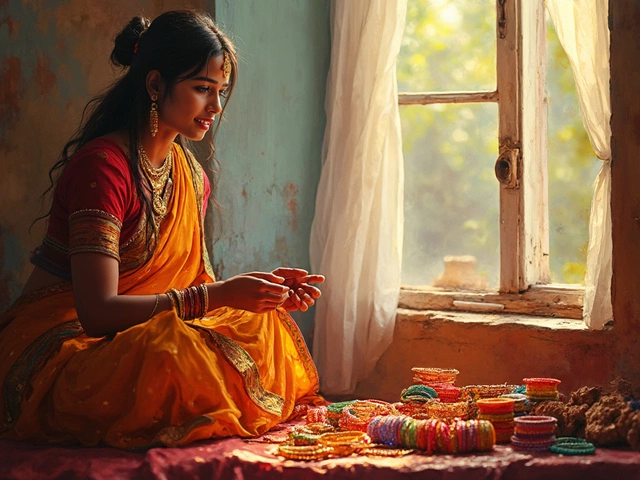Have you ever strolled past an Indian jewelry store and found yourself mesmerized by the intricate designs and vibrant colors? You're not alone. Indian jewelry, especially the traditional temple jewelry, has a way of capturing the eye and spirit, transcending cultural boundaries.
But you might wonder, can you wear it without belonging to that culture? In recent times, fashion lovers from all corners of the world have been drawn to these exquisite pieces, not just for their beauty but for their history and craftsmanship.
Before you decide to sport that stunning necklace or those elegant earrings, it's crucial to understand what you're embracing. Temple jewelry isn't just another fashion accessory; it carries the weight of history, spirituality, and artistry. This kind of jewelry was originally designed for adorning deities in temples, which later influenced classical Indian dance forms with its breathtaking motifs and designs.
Wearing Indian jewelry can be a delightful way of appreciating its artistic and cultural depth. With some insights and thoughtful choices, you can honor its heritage while making it a part of your fashion statement.
- Understanding Temple Jewelry
- Cultural Significance of Temple Jewelry
- Global Appeal and Fusion
- Cultural Appreciation vs. Appropriation
- Tips for Wearing Indian Jewelry Respectfully
- Creating Your Unique Style
Understanding Temple Jewelry
Temple jewelry boasts a rich heritage that dates back thousands of years in India, specifically used initially in the ornate adornment of deities in temples. These works of art were crafted with precision, often using precious metals like gold, silver, and studded with gemstones such as rubies, emeralds, and pearls.
The roots of temple jewelry are deeply entwined with South Indian culture, particularly in states like Tamil Nadu and Karnataka. Each piece tells a story, representing religious influences and showcasing divine figures, motifs, and scenes from epic mythology. Initially, temple jewelry was exclusive to temple dancers or 'devadasis', who wore them during their spiritual performances.
Beyond the temples, these beautiful ornaments found their way into traditional Indian dance forms such as Bharatanatyam and Kuchipudi. As dancers moved with grace, the jewelry amplified both the aesthetic appeal and cultural essence of their storytelling art.
Materials and Craftsmanship
Traditional Indian jewelry was meticulously handcrafted, a true labor of love. The process often involves artisans who have honed their skills over generations, passing down unique techniques and artistic vision. Modern variations might include brass and copper, making it more accessible yet equally stunning.
Shapes and designs feature lotus flowers, peacocks, and historic deities which have grown in popularity, inspiring both traditional wearers and contemporary fashion enthusiasts worldwide.
The Modern Day Appeal
In today's fashion world, temple jewelry is cherished not just for its historical value but also for its captivating beauty. Fashionistas love pairing these pieces with modern attire to create a fusion look that's chic and respectful of tradition.
This blend of old and new plays a massive role in its global appeal. It's not uncommon to find celebrities and fashion bloggers wearing temple jewelry at events and in daily life, sparking interest and admiration from different cultures.
Cultural Significance of Temple Jewelry
Temple jewelry isn't just a feast for the eyes; it's a deep dive into India's rich cultural tapestry. Originally created for deities in South Indian temples, these pieces are a testament to the country's spiritual and artistic heritage. They were meticulously crafted from pure gold and adorned with precious gems like rubies, emeralds, and pearls. The idea was to embody divinity, beauty, and affluence all in one.
One of the most fascinating aspects is that this jewelry style eventually found its way into the classical Indian dance scene. It became the hallmark of dancers in Bharatanatyam and Kuchipudi, where ornaments are not just decorations but integral to storytelling through dance. Think of it as a visual language that speaks of age-old traditions and lore.
Spiritual Echoes
The temple jewelry carries spiritual significance too. In many communities, it's believed to bless the wearer with prosperity and protection. This isn't mere folklore; each piece is designed with symbols of divine entities. Wearing them is like carrying a piece of history and spirituality with you.
The Craftsmanship Behind the Beauty
The craftsmanship of Indian jewelry is another facet that's awe-inspiring. It requires skilled artisans who dedicate countless hours to perfecting each piece. Imagine hammering out delicate patterns or setting gemstones with precision—a single mistake could ruin the entire piece. This artistry isn’t just a trade; it's a legacy passed down through generations.
The global appeal of temple jewelry continues to grow. Celebrities and fashion icons worldwide are attracted to its beauty and story, making it not just a staple in Indian households but a sought-after item on international red carpets as well.
Global Appeal and Fusion
Indian jewelry, and particularly temple jewelry, has found fans in fashion-forward folks from all around the world. The allure isn't difficult to understand. These pieces are crafted with meticulous attention to detail, often using intricate gold work and vibrant gemstones. But it's not just about aesthetics; it's about a connection to something timeless and unique.
So, how did this captivating style of jewelry cross borders? The answer lies in the globalized fashion industry, where Indian jewelry has become a staple in the collections of both high-end and street fashion designers. Pairing traditional pieces with modern outfits has become a trend, adding a distinctive edge to Western fashion wardrobes.
For those blending traditional and contemporary styles, Indian jewelry offers endless opportunities. Imagine wearing a classic temple necklace with a simple white tee or combining Indian earrings with a little black dress. It’s all about creating that perfect fusion.
Collaborations in Fashion
Fashion houses are increasingly recognizing the appeal of Indian jewelry. Several designers have integrated these pieces into their collections, showcasing them on runways across New York, Paris, and Milan. Think about influencers and celebrities gracing red carpets with stunning Indian accessories—it’s a trend that’s only growing.
In fact, various fashion collaborations highlight this fusion. Designers often team up with Indian artisans to create exclusive, limited-edition collections that celebrate the essence of both worlds. This not only adds variety to their offerings but also supports the traditional craftsmanship of Indian jewelers.
Statistics on Jewelry Exports
The popularity of Indian jewelry is also reflected in export statistics. Did you know that India is one of the top exporters worldwide? Check out this quick snapshot of the industry:
| Year | Jewelry Export Value (in Billion USD) |
|---|---|
| 2022 | 40 |
| 2023 | 42 |
These numbers give a clear picture—there's definitely something magical about the appeal of Indian jewelry. Whether it's for a cultural celebration or a fashion statement, this jewelry resonates with diverse audiences globally.

Cultural Appreciation vs. Appropriation
So, you're eyeing that shiny piece of Indian jewelry but worried if it's okay to actually wear it? Well, here's the deal: it's important to know the difference between appreciating another culture and stepping into the sticky territory of appropriation.
Cultural appreciation is all about learning, respecting, and valuing the elements of a culture that's not your own. Imagine you're at an Indian wedding. You see all the beautiful sarees and temple jewelry, and you're genuinely interested in knowing their meanings and how they're made. That's appreciating the culture, and it's generally met with smiles and welcomes.
On the flip side, cultural appropriation happens when someone takes a part of a culture, usually one that isn't theirs, strips it of its original significance, and uses it in a disrespectful or superficial way. Consider this: wearing sacred symbols as mere fashion statements or using them without understanding their importance isn't just frowned upon, it's offensive to many.
How to Appreciate Without Appropriating
- Research: Before you hit 'buy' on that dazzling piece of temple jewelry, take a moment to learn about its history and significance. Knowing it adds depth to your choice and helps you appreciate it more fully.
- Ask Questions: If possible, talk to someone from the culture or the vendor selling the piece. They can provide valuable insights and stories behind the designs.
- Support Authentic Craftsmanship: Look for ethical brands or artisans who create authentic pieces. This ensures that your purchase supports the culture and the people who belong to it.
In fact, there was a study showing that 60% of consumers prefer buying cultural items from authentic sources when aware of the option. This choice respects the artisans who put their heart into crafting each piece, ensuring they retain control and pride over their tradition.
Remember, temple jewelry isn't just fabulous; it represents a tradition that's rich and meaningful. It's about honoring the culture while you adorn yourself with its beauty.
Tips for Wearing Indian Jewelry Respectfully
So you've fallen in love with Indian jewelry, and you're ready to make it a part of your collection. That's amazing! But remember, with its rich cultural roots, it's important to approach wearing it with respect and understanding.
Do Your Homework
Start by learning about the history and symbolism behind the pieces you’re interested in. Temple jewelry, for example, has deep religious and cultural significance, initially crafted for deities. Understanding this can add meaning to your purchase and help you wear it with pride.
Respectful Wearing
- Choose occasions wisely. Wearing temple jewelry to cultural or traditional events shows appreciation. Think about festivals, weddings, or concerts featuring Indian music and dance.
- Pair it thoughtfully. Mix it with your everyday wardrobe but keep it balanced. Let the jewelry be the highlight without overwhelming your look.
Support Artisans
Whenever possible, buy authentic pieces made by Indian artisans. This supports their craft and ensures you're getting the real deal. Look for fair-trade labels or reputable sellers who prioritize ethical sourcing.
Ask Questions
When shopping, don’t hesitate to ask sellers or artisans about the history or making of the jewelry. They often have wonderful stories to share, adding a layer of personal connection to your pieces.
Avoid Cultural Faux Pas
- Avoid mixing deep symbolic pieces with novelty items as it can be seen as disrespectful.
- Be mindful of any sacred symbols. If you're unsure about something, a quick internet search or a polite question can go a long way.
By taking these steps, you’ll not only look great in Indian jewelry but you'll also carry its cultural weight with sensitivity and grace.
Creating Your Unique Style
So, you’re ready to rock some Indian jewelry, but you're unsure how to fit it into your wardrobe without looking like you're off to a costume party? Worry not! Incorporating temple jewelry, like a pro, is totally doable and can elevate your style game.
Blend Tradition with Modern
The trick is to mix and match. Pairing traditional pieces with modern outfits is a win-win. For example, a bold Indian necklace can be a standout piece over a simple black dress or a casual white shirt.
- Statement Earrings: Let a pair of dazzling earrings do the talking when you wear minimalistic or monochrome outfits.
- Layering: Play with the concept of layering by wearing multiple necklaces of varying lengths. It's creative and absolutely stylish!
- Balance: If you're wearing heavy jewelry on your neck, keep the rest of your accessories simple to avoid overwhelming your look.
Casual to Ethereal
Believe it or not, temple jewelry can be worn in both casual and formal settings. It's all about how you style it. Throw in a simple bangle with your jeans or a set of rings, and you've added a touch of elegance without much effort.
Color Coordination
The colors of temple jewelry are usually vibrant with stones and gold hues. They can brighten your look, but it’s key to coordinate with your clothing. Stay aware of the color wheel; contrasting colors can create a refreshing pop, while analogous colors give a harmonious look.
| Occasion | Jewelry Piece | Suggested Outfit |
|---|---|---|
| Office | Modest Ring & Bangles | Blouse & Trousers |
| Casual Outing | Statement Earrings | Jeans & Tee |
| Evening Event | Layered Necklaces | Little Black Dress |
Confidence is Key
Here’s the thing: no matter how you decide to wear Indian jewelry, make sure you own that look with confidence. That’s what truly makes a style statement. So go ahead, explore this cultural trove, and feel fabulous as you create your unique style!



